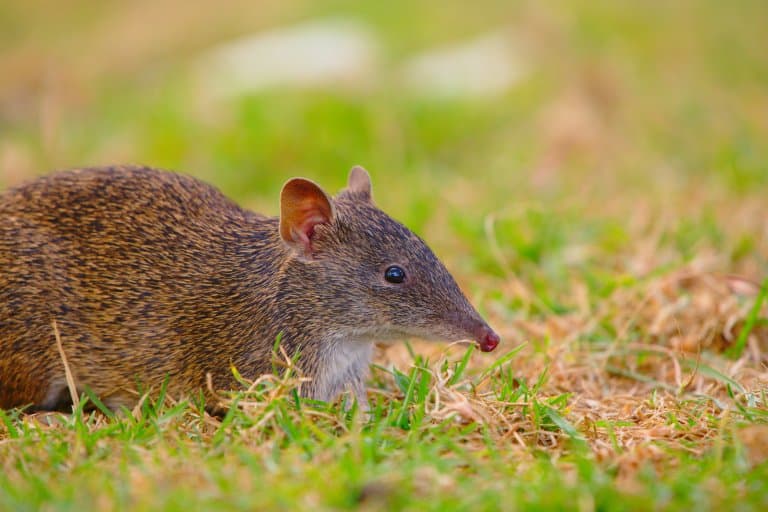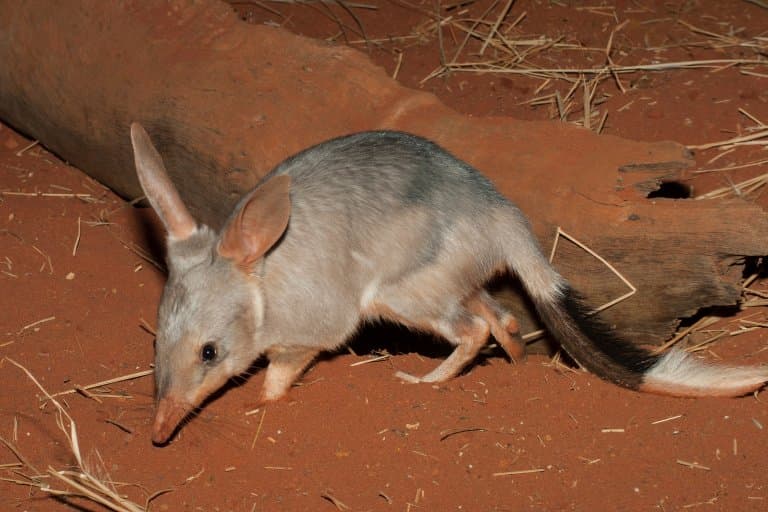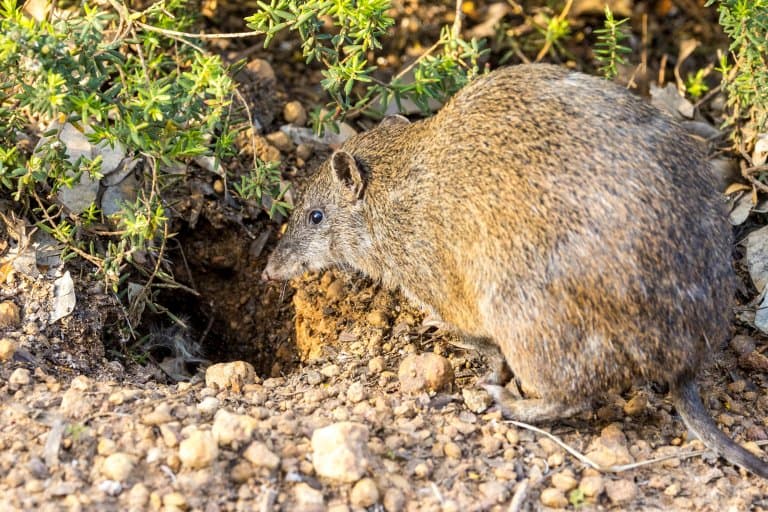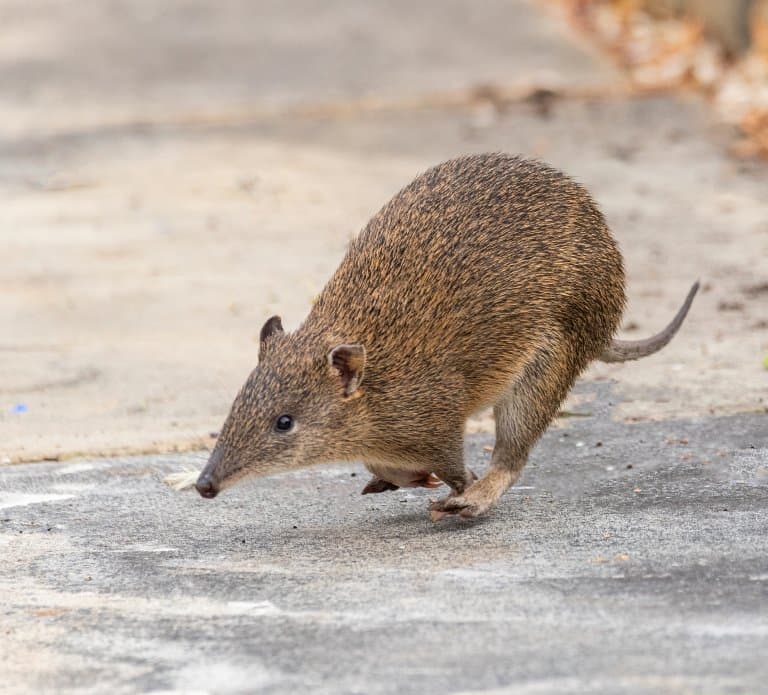Bandicoot Profile
Bandicoots are a group of small omnivorous marsupials with V-shaped faces, which consist of around 20 species. They are only found in Australia, Tasmania and the islands of New Guinea.
Bandicoots are adaptable creatures and depending on the species, are found in a variety of habitats. They tend to prefer more forested areas, though some species are found along coastlines and even in semi-arid regions.
The term bandicoot is often used informally to also refer to the bilby that are in the same order, Peramelemorphia.

Bandicoot Facts Overview
| Habitat: | Generally forests and rainforests but can be found along coastlines and in drier areas |
| Location: | Australia, Tasmania, New Guinea and nearby islands |
| Lifespan: | 5 years in the wild |
| Size: | Body length 30-80 cm, tail length 10-30 cm |
| Weight: | 0.4 – 3.5 lb (0.18 – 1.6 kg) |
| Color: | Black to light tan, sometimes with lighter markings |
| Diet: | Omnivorous, mainly feeding on insects, seeds and fruit |
| Predators: | Foxes, dogs, cats, owls, quolls, dingoes and snakes |
| Top Speed: | 25 kph (15 mph) |
| No. of Species: |
20 |
| Conservation Status: |
Least Concern to Endangered |
Most bandicoots are similar in size to a large rat, however the greater bilby is about the size of a large rabbit and has huge ears which give it the common name, “rabbit-bandicoot”. Bandicoots coat colour depends on the species but their fur is generally coarse and their eyes are small, both of which are important adaptations when tunnelling underground.
These small marsupials are perfectly adapted to an active lifestyle, with longer back legs making them incredibly quick over short distances. The strong claws that bandicoots possess allow them to not only dig burrows but also dig for insect larvae as well as giving them excellent grip when fleeing from predators. They have long noses and large ears which allows them to smell and hear potential food items from relatively long distances away.
All species are prolific diggers and spend much of their time in underground burrows. They are poor climbers and are mainly nocturnal, preferring to forage at night to avoid predators.
Most are omnivorous, feeding on insects as well as seeds, grasses and fruits. Some species feed on larger prey such as mice and lizards and other species feed mostly on plants. Bandicoots are however optimistic foragers and will readily eat any edible insects or plants they encounter.
Bandicoots are not social animals and prefer spending their time alone. Males and females rarely interact unless during the breeding season. They can also be rather territorial and males will often fight each other if defending or attempting to take over a territory. Bandicoots have sharp teeth and claws and during these fights, it is quite common for the loser to leave missing part of a tail or ear.
As with other marsupials, young bandicoots are born prematurely into their mother’s pouch. Here they feed on her milk for sometimes over 2 months before being able to move around in their burrows. Even though they breed at a fast rate, juvenile bandicoots make easy prey for predators and thus their populations tend not to expand to a greater extent than their habitats can hold.
Although considered a crop pest or garden nuisance in some areas, bandicoots do in fact play a crucial role in the ecosystem. Their burrowing antics turn over the soil, allowing for better soil aeration and nutrient mixing. This means seeds are able to germinate more easily, creating new habitats in that area.
By feeding on fungi they are also crucial in transferring fungal spores to new areas they visit during their nightly foraging. Bandicoots are also prey to raptors and carnivorous mammals, thereby providing a reliable food source for such predators during the drier seasons.
Interesting Bandicoot Facts
1. The word “bandicoot” means pig-rat
In the Telugu Indian language, bandicoot means pig-rat due to the grunting sounds bandicoots make and their rat like features.
Indigenous people of Australia refer to bandicoots as the ‘bung’ or the ‘marti’.1
2. Bandicoots inspired a very popular video game
The main character of the video game “Crash Bandicoot” was an eastern barred bandicoot.

3. They have an extremely short pregnancy
Female bandicoots can be pregnant for as short as 11 days before giving birth. 2
4. They use their long nose for more than smell
As well as smelling with their long noses, bandicoots press their noses into small holes in the ground to collect insects and plants.
5. They are an alternative to the Easter Bunny
In Australia, people can buy chocolate Easter bilbies instead of Easter bunnies.

6. Baby bandicoots can measure as little as 1 cm when born
Bandicoots can produce young at a very early age and females will often have a new joey in their pouch while still caring for their older joeys.
7. They can make a mess in gardens
In urban areas, digging bandicoots leave funnel shaped mounds, called nose pokes.
8. Bandicoots can be a gardener’s friend
Despite leaving holes in lawns, bandicoots eat many insect pests which feed on garden flowers and other plants. They also eat cockroaches, spiders (including the venomous funnel-web spider) and even mice. 3
9. Bandicoots can swim
Though not great swimmers, bandicoots can cover small bodies of water fairly easily.
10. They are very active during the night
For such small animals, bandicoots have large territories which they will cover in a single night in search of food.
11. Females have a backward facing pouch
Unlike most other marsupials, but similar to the wombat, a bandicoot pouch faces backwards so that dirt and the like does not enter it when the female is digging through soil.

12. When frightened, they hop high into the air
After an initial high jump, bandicoots can flee predators with surprisingly speedy hops.
Much like kangaroos, bandicoots also use their long back legs to hop around, leaving their front legs free to dig for insects or plants.
13. They are vocal
Despite being quite shy marsupials, bandicoots are vocal animals.
When they dig, they produce grunts and snuffles and can make very high pitched squeals when surprised or during fights.
They can also make high-pitched bird-like noises to locate one another, and ‘whuff, whuff’ noises when irritated.
14. Some bandicoots like a more urban lifestyle
The Southern brown bandicoot has been observed in good numbers on the outskirts of Melbourne in Australia. Some were even found eating domestic pet food from back gardens. 4

15. Certain bandicoots have been brought back from the edge of extinction
In the past the number of Eastern barred bandicoots was severely impacted by predators, such as foxes. In the 1980s there were thought to only be around only 150 individuals.
Predator free sites were created, some even on islands or protected by trained dogs. Numbers are now thought to be at around 1,500. They are now listed as ‘endangered’ rather than ‘extinct in the wild’. 5
Bandicoot Fact-File Summary
Scientific Classification
| Kingdom: | Animalia |
| Phylum: | Chordata |
| Class: | Mammalia |
| Order: | Peramelemorphia (Bandicoots and bilbies) |
| Family: | Peramelidae (bandicoots and echymiperas) Chaeropodidae (Pig-footed bandicoot) Thylacomyidae (Bilbies) |
| Subfamily: | Echymiperinae – Echymiperas and Papuan bandicoots Peramelinae – Australian bandicoots Peroryctinae – Giant and raffray’s bandicoots |
Fact Sources & References
- “Bandicoots“, Bush Heritage Australia.
- “About bandicoots“, Queensland Government.
- NSW Gov (2018), “Bandicoots“, NSW Department of Planning and Environment.
- Euan Ritchie and Sarah Maclagan (2018), “Endangered bandicoots live among us in Melbourne“, Australian Geographic.
- BBC News (2021), “Australian bandicoot brought back from brink of extinction“, BBC.
